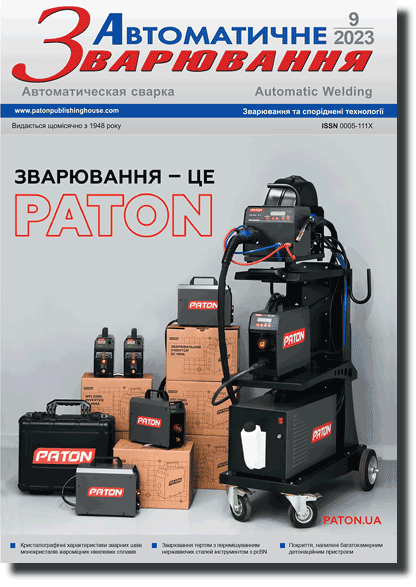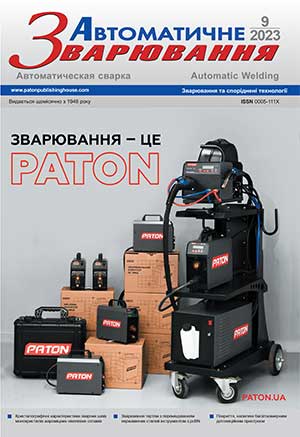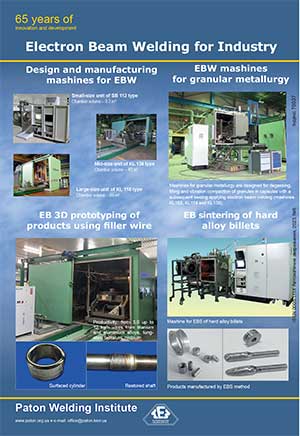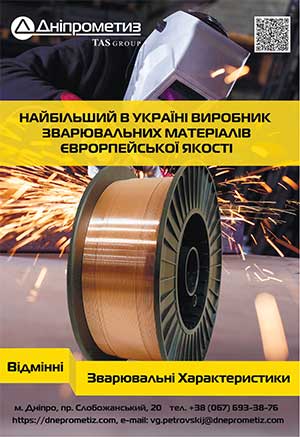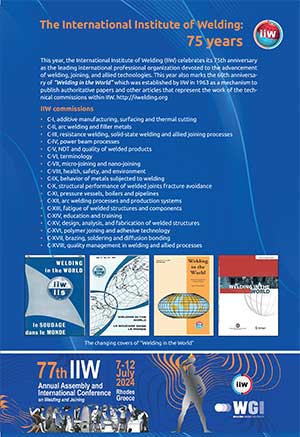Access for download PDF files for subscribers and for reviewers of scientometric bases.
Organization: Elsevier for content access(PDF files of journals released before 2024 are available for download from the website's archives))
Organization: Elsevier for content access(PDF files of journals released before 2024 are available for download from the website's archives))
| 2023 №09 (04) |
DOI of Article 10.37434/as2023.09.05 |
2023 №09 (06) |
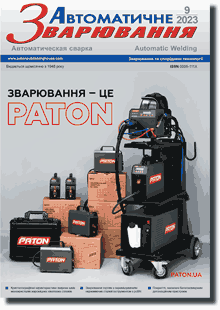
"Avtomatychne Zvaryuvannya" (Automatic Welding), #9, 2023, pp. 29-33
Diffusion welding of magnesium alloy МА2-1 through a zinc interlayer
Yu.V. Falchenko, L.V. Petrushynets, V.Ie. Fedorchuk, V.A. Kostin, O.L. Puzrin
E.O. Paton Electric Welding Institute of the NAS of Ukraine. 11 Kazymyr Malevych Str., 03150, Kyiv, Ukraine. E-mail: office@paton.kiev.uaThe paper gives the results of investigations on vacuum diffusion welding of МА2-1 magnesium alloy. Different technological measures were used in welding: unsupported welding, welding with application of forming matrices, welding without interlayers and with a zinc interlayer. It is found that it is not possible to produce the joint in unsupported welding without an interlayer at 400 °С temperature and process duration less than 60 min. Increase of welding temperature or time leads to considerable grain growth. Application of 250 ~m zinc interlayer and of the following welding mode: Т = 320 ºС, Р = 10 MPa, t = 30 min allows producing the joint. Analysis of chemical composition in different areas of the joint zone shows that development of diffusion processes in the butt during welding results in pore formation with magnesium content on the level of 17.8 – 20.12 wt. % in the zinc interlayer at 2 – 3 ~m distance from magnesium/zinc contact line. In the central part of the joint zone the metal chemical composition is close to pure zinc composition. Application of forming matrices and an interlayer of zinc in the solid-liquid state in welding in the following mode: Т = 340 ºС, Р = 10 MPa, t = 30 min. allows producing sound joints due to localisation of plastic deformation in the butt joint. Results of metallographic investigations showed formation in the butt joint of common grains and remains of the interlayer in the form of dispersed particles of 15…50 ~m size, with chemical composition of Mg–4.53Al–0.20Mn–63.49Zn, wt. %, having an irregular elongated shape.
Keywords: vacuum diffusion welding, magnesium alloy, interlayer, microstructure, microhardness
Received: 05.07.2023
References
1. Manoj Gupta, Nai Mui Ling Sharon (2011) Magnesium, magnesium alloys, and magnesium composites. Hoboken, New Jersey, John Wiley & Sons, Inc. https://doi.org/10.1002/97804709050982. Gialanella S., Malandruccolo, A. (2020) Aerospace Alloys. Springer, Cham. https://doi.org/10.1007/978-3-030-24440-8
3. Min, D., Shen, J., Lai, S., et. al. (2009). Effect of heat input on the microstructure and mechanical properties of tungsten inert gas arc butt-welded AZ61 magnesium alloy plates. Materials Characterization, 60 (12), 1583-1590. https://doi.org/10.1016/j.matchar.2009.09.010
4. Abbas, M., Khan, A., Ali, M. et. al. (2014) Effect of weld current and weld speed on the microstructure and tensile properties of magnesium alloy specimens during tungsten inert gas. Technical J., 19 (II), 35-39.
5. Fei, Lin, Tiepeng, Li, Lulu, Sun, Qingsen, Meng. (2012) A study on vacuum diffusion bonding of as-extruded AZ31 magnesium alloy. Applied Mechanics and Materials, 121- 126 (10-14). https://doi.org/10.4028/www.scientific.net/AMM.121-126.10
6. Fei, Lin, Jie, Li, Hongwei, Zhao et. al. (2013) Experimental Research on Vacuum Diffusion Bonding of As-extruded AZ61 Magnesium Alloy. Advanced Materials Research, 788, 34-37. https://doi.org/10.4028/www.scientific.net/AMR.788.34
7. Zhang, Weixiang, Du, Shuangmin (2013) Investigation into Cu-interlayered Diffusion Bonding Trial of AZ31B Alloy. Advanced Materials Research, 631-632 (167-171). https://doi.org/10.4028/www.scientific.net/AMR.631-632.167
8. Torun, O., Karabulut, A., Baksan, B. et. al. (2008) Diffusion bonding of AZ91 using a silver interlayer. Materials and Design, 29, 2043-2046. https://doi.org/10.1016/j.matdes.2008.04.003
9. Reza, Ghavami, Ayoub, Halvaee, Amir, Hadian (2019) Effect of bonding temperature on interface properties of AZ31 magnesium alloys joined by transient liquid phase using silver interlayer. Materials Research Express, 6, 1-9. https://doi.org/10.1088/2053-1591/ab44df
10. Sun, D.Q., Liu, W.H., Gu, X.Y. (2004) Transient liquid phase bonding of magnesium alloy (Mg-3Al-1Zn) using copper interlayer. Materials Science and Technology, 20 (12), 1595-1598. https://doi.org/10.1179/174328413X13789824293506
11. Jin, Y.J., Khan, T.I. (2012) Effect of bonding time on microstructure and mechanical properties of transient liquid phase bonded magnesium AZ31 alloy. Materials and Design, 38, 32-37. https://doi.org/10.1016/j.matdes.2012.01.039
12. AlHazaa, A.N., Khalil Abdelrazek Khalil, Muhammad A. Shar (2016) Transient liquid phase bonding of magnesium alloys AZ31 using nickel coatings and high frequency induction heat sintering. J. of King Saud University Science, 28, 152-159. https://doi.org/10.1016/j.jksus.2015.09.006
13. GOST 14957-76 Wrought magnesium alloys. Grades [in Russian].
14. Morozova, G.I. (2008) Phase composition and corrosion resistance of magnesium alloys. Metallovedenie i Termich. Obrab. Metallov, 3, 8-12 [in Russian]. https://doi.org/10.1007/s11041-008-9020-9
15. Shi, Z.Z., Zhang, W.Z. (2013) Prediction of the morphology of Mg32(Al, Zn)49 precipitates in a Mg-Zn-Al alloy. Intermetallics, 39, 34-37. https://doi.org/10.1016/j.intermet.2013.02.023
16. Piskun, N.V., Falchenko, Yu.V., Petrushinets, L.V. (2020) Formation of the structure and mechanical properties of joints of TiAlNb intermetallic alloy in diffusion welding. The Paton Welding J., 2, 2-8. https://doi.org/10.37434/tpwj2020.02.01
17. Okamoto, H. (1994) Comment on Mg-Zn (magnesium-zinc). J. of Phase Equilibria, 15, 129-130. https://doi.org/10.1007/BF02667700
Advertising in this issue:
The cost of subscription/purchase order journals or individual articles
| Journal/Currency | Annual Set | 1 issue printed |
1 issue |
one article |
| TPWJ/USD | 384 $ | 32 $ | 26 $ | 13 $ |
| TPWJ/EUR | 348 € | 29 € | 24 € | 12 € |
| TPWJ/UAH | 7200 UAH | 600 UAH | 600 UAH | 280 UAH |
| AS/UAH | 1800 UAH | 300 UAH | 300 UAH | 150 UAH |
| AS/USD | 192 $ | 32 $ | 26 $ | 13 $ |
| AS/EUR | 180 € | 30 € | 25 € | 12 € |
| SEM/UAH | 1200 UAH | 300 UAH | 300 UAH | 150 UAH |
| SEM/USD | 128 $ | 32 $ | 26 $ | 13 $ |
| SEM/EUR | 120 € | 30 € | 25 € | 12 € |
| TDNK/UAH | 1200 UAH | 300 UAH | 300 UAH | 150 UAH |
| TDNK/USD | 128 $ | 32 $ | 26 $ | 13 $ |
| TDNK/EUR | 120 € | 30 € | 25 € | 15 € |
AS = «Automatic Welding» - 6 issues per year;
TPWJ = «PATON WELDING JOURNAL» - 12 issues per year;
SEM = «Electrometallurgy Today» - 4 issues per year;
TDNK = «Technical Diagnostics and Non-Destructive Testing» - 4 issues per year.





